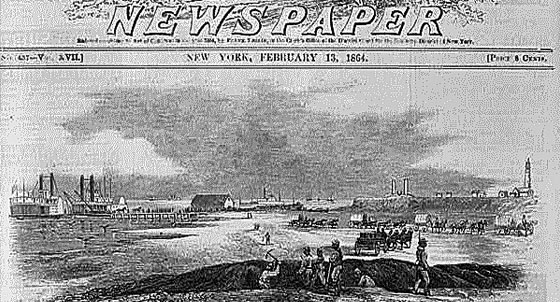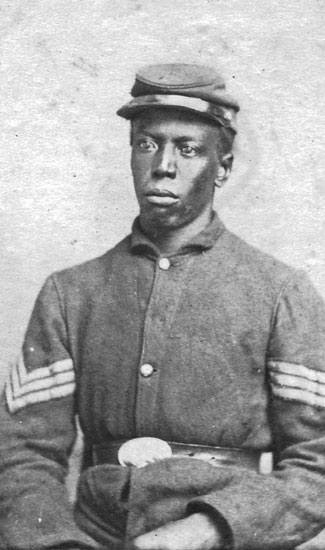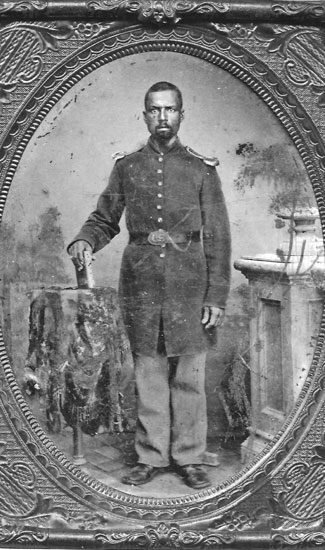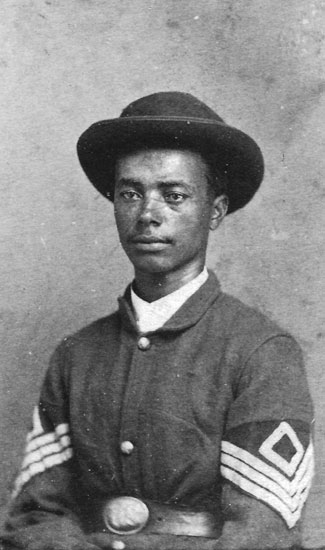U.S. Colored Troops
Early in 1863, Abraham Lincoln observed: “The colored population is the great available yet unavailed of force for restoring the Union.” Two months later the War Department issued General Order #143 which sanctioned the creation of the United States Colored Troops (USCT).Three regiments of the USCT entered the Rio Grande Valley in the fall of 1864. Encamped at Brazos Santiago, a detachment of the 62nd Infantry fought Confederates at the Battle of Palmito Ranch on May 13, 1865. Two weeks later, on May 30, the 62nd, along with other U.S. Army units, moved into Brownsville. By May 1865, nearly 16,000 USCT veterans of the 25th Corps arrived at Brazos Santiago from City Point, Virginia, and were quickly dispersed to Forts Brown at Brownsville, Ringgold Barracks at Rio Grande City, Fort McIntosh at Laredo, and Fort Duncan at Eagle Pass, as well as to smaller posts where they were assigned to prevent former Confederates from establishing their defeated government and army in Mexico. Later, the USCT, along with their successors the "buffalo soldiers"—as they were called by Plains Indians—patrolled the border to stop ongoing violence in Mexico from spilling into the United States, and to discourage bandits and Indians from attacking civilian communities. The black soldiers made a fine adjustment to the hot desert terrain and diverse culture of the Valley, as explained by Sergeant Major Thomas Boswell of the 116th: "If our regiment stays here any length of time we will all speak Spanish, as we are learning very fast." The last USCT regiment, the 117th U.S. Colored Infantry, left the Rio Grande in July 1867.
Listen
Tres regimientos pertenecientes al U.S.C.T. (siglas en inglés de United States Colored Troops, un contingente conocido como el «Regimiento Negro»), entraron en El Valle en el otoño de 1864. Acuartelados en la Isla de Brazos Santiago, este cuerpo fue organizado después de que el presidente Abraham Lincoln promulgara la Emancipación de los esclavos en Estados Unidos en 1863. Un destacamento la 62 de Infantería combatió a los confederados en la Batalla de Rancho Palmito el 13 de mayo de 1865. Dos semanas después, el 30 de mayo, la 62 y otras unidades del ejército se desplazaron hasta Brownsville y ya para entonces casi 16 000 veteranos del regimiento negro del 25º Cuerpo del ejército habían llegado desde City Point, Virginia. Pronto fueron desplegados, distribuyéndose entre los fuertes Brown, de Brownsville, Ringgold, de Río Grande City, McIntosh, de Laredo, y Ducan, de Eagle Pass, así como en otros emplazamientos menores, a fin de evitar que los antiguos confederados establecieran un gobierno en el exilio y un ejército en México. Posteriormente, el Regimiento Negro y sus sucesores, los llamados «soldados búfalo» (tal como los denominaban los indios de las praderas) patrullaron la frontera para evitar que la violencia que se desarrollaba en México se propagara a través de la frontera en los Estados Unidos, así como para disuadir a bandidos e indios de atacar a las comunidades locales. Los soldados negros se ajustaron bien al árido terreno desértico y a la diversidad cultural de El Valle, tal como reflejó el sargento mayor Thomas Boswell de la 116: «Si nuestro regimiento permanece aquí tiempo suficiente acabaremos hablando todos español, porque estamos aprendiendo muy rápido». La última compañía del Regimiento Negro, la 117, abandonó el Río Grande en julio de 1867.
Escucha
Details
Description: Federal African American soldiers of the Civil War, known as United States Colored Troops (U.S.C.T.), were first sent into the Rio Grande Valley in the fall of 1864. In June 1865 about 16,000 more U.S.C.T. were sent here to guard the river and occupied posts until July 1867.
- Location: Brazos Santiago
Post occupied by the U.S. Army from Fall 1863 through the end of the Civil War and after. Occupied by USCT in the Fall of 1864, including the 62nd, 87th, and 91st USCI. Staging point for the campaign towards Palmito Ranch in May 1865. Later, June 1865-1867, primary landing point by USCT under the 25th Corps, District of the Rio Grande. These USCT built a railroad from here to White’s Ranch in late 1865. - Location: Clarksville, Texas
Post of USCT, 25th Corps, District of the Rio Grande, 1865-1867. Occupied by companies of the 45th, 46th, and 118th USCI and 2nd USCC among others. Point of departure for two movements into Bagdad, Mexico, July 1865 (45th) and Jan. 1866 (46th, 118th, 2nd) in support of Liberal forces. - Location: Fort Brown
Major post on the Rio Grande. Occupied by U.S. Army Nov. 1863- July 1864 and again after May 30, 1865. HQ of 25th Corps (Maj. Gen. Godfrey Weitzel) and District of the Rio Grande (Maj. Gen. Frederick Steele), June 1865-1867. Garrisoned by various USCT regiments including the 19th and 114th USCI who built a pontoon bridge across the river and invaded Matamoros in Nov.-Dec. 1866. - Location: Palmito Ranch
Site of May 12-13, 1865 Civil War battle between U.S forces under Col Theodore Barrett (62nd USCI, 34th Indiana Inf., and 2nd Texas Cav.) and C.S. forces under Col. John “Rip” Ford. The battle was a Confederate victory with numerous U.S. soldiers captured and the majority returning to Brazos Santiago. - Location: White’s Ranch
Encampment of the 62nd USCI, 34th Indiana Inf., and 2nd Texas Cav. (US) on their march toward Palmito Ranch (May 9-10, 1865). Post for USCT, 25th Corps, District of the Rio Grande, June 1865-1867. These troops built a railroad line from here to Brazos Santiago (Dec. 1865). The 116th USCI suffered from a Cholera epidemic here in August 1866 which “destroyed the lives of forty-five men”.
- Location: Edinburgh, Texas (City of Hidalgo)
Post of USCT under 25th Corps, District of the Rio Grande, June 1865-1867. Various regiments/companies stationed here including Cos. A, D, H, and K of the 116th USCI (Fall 1865) and Co. G of the 114th USCI(Spring 1866).
- Location: Ringgold Barracks, Texas
Major post of USCT, 25th Corps, District of the Rio Grande from June 1865-1867. Regimental HQ of the 114th USCI (Spring 1866) (Winter-Spring 1867). Last post of last USCT (117th USCI) in Rio Grande Valley- left July 1867 and replaced by the 41st US Infantry. - Location: Roma, Texas
Post for USCT, 25th Corps, District of the Rio Grande, June 1865-1867. Regimental HQ for 116th USCI, Summer 1865 and post for companies of 31st and 114th USCI. In August 1865 four companies of 116th and 31st pursued Kickapoo raiding party from Mexico.
- Location: Various smaller sites - Arsenal, Barrancas, Cortina, Redmond’s, and Santa Maria Ranches
PThese ranches were all small posts for USCT companies from 1865-1867. Companies of the 114th USCI at Redmond’s and Companies of the 116th USCI at Arsenal and Santa Maria.
- Location: Fort McIntosh, Texas
Major post of USCT, 25th Corps, District of the Rio Grande from June 1865-1867. Cos. A and I of the 114th USCI here Spring 1866. In July 1867 occupied by companies of the 41st US Infantry.
Photos

Black soldiers digging trenches north end
Brazos Island 1864 - Frank Leslie's
Illustrated Newspaper 1864. Courtesy of
Texas State Library and Archives Commission

Sgt. George Mitchell, Company D, Sixty-second
U.S. Colored Infantry - Carte de Visite by
unidentified photographer, about 1864-1866.
Collection of the Gettysburg National Military
Park Museum.


